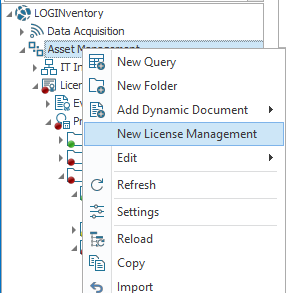License Management
You can use license management to compare the number of licenses with the number of purchased licenses that have been used, and thus carry out a target/actual comparison.
This gives you an overview of how many licenses are used according to the respective license conditions, how many licenses are too few or how many licenses are too many.
Attention
These data are important to document the software compliance of the company and to prove that the license conditions of the manufacturers are being adhered to during both internal audits and external audits.
Info
In addition, it is possible to evaluate the usage of software products. This enables you to find out on which computers installed software is not being used, which can reveal considerable savings potential, especially with expensive software.
In license management different types of products can be managed, e.g. software, operating systems, CALs or fonts.
If required, the distinctions between licensing per device, licensing per user and licensing per VM via host are always available.
In total, different metrics (= calculation rules) are supported in order to map various license models and deployment scenarios.
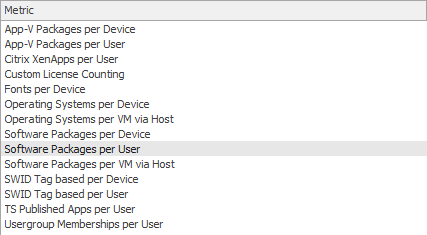
When storing licenses, different license types are available, including Pool licenses, Device licenses, User licenses, Subscription licenses and Maintenance licenses.
Conclusion
To use license management, you must identify the products that are subject to license requirements and store the existing licenses.LOGINventory helps you to get an overview of existing and used licenses and to identify unused software, and has one goal: optimizing the license inventory.
Adding Products to License Management
To add a product to license management, the function New Product can be selected from the ribbon menu if the node License Management has been selected in the tree structure.

This opens a wizard for creating license products. In the wizard you can set which products are to be added and how the consumption calculation is defined.
Define Products
The first step is to define how the consumers of the licenses can be identified (e.g. presence of a certain software package). However, LOGINventory already recognizes many products automatically.
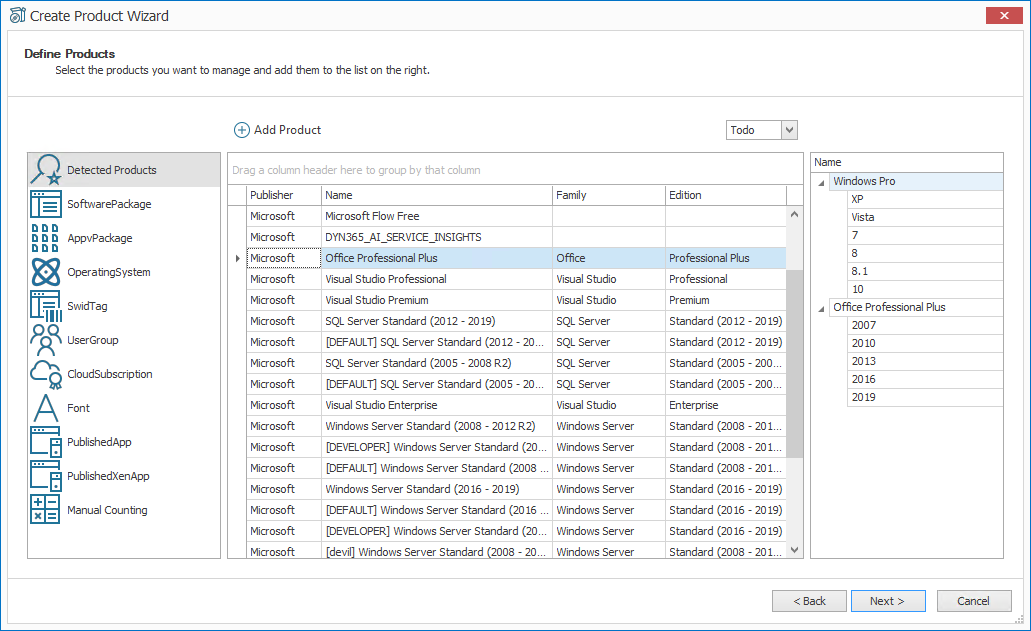
The products to be managed in LOGINventory can be added to the list on the right by clicking on add product. This can also be done by double-clicking.
Detected Products
Based on the data from the inventory of the network, many licensed products are already recognized. The correct versions and settings for the metric (see below) are automatically created here. Several recognized products can also be selected and added simultaneously using the control and shift keys.
Info
If virtualized products subject to license, such as SQL Server or Windows Server, have been detected, there may be multiple entries on different hosts for a single product. This is necessary because with virtualized software or operating systems, the licenses must always be explicitly assigned to the host due to the license conditions, i.e. extra entries in the license management are required. These hosts are always identified by a square bracket. 
Software packages
From the list of all found software packages further corresponding products can be identified and added to the list on the right side. The result set can also be restricted with the help of filtering.
Attention
When installing a software product, several software packages are often installed. In order for the consumers of the licenses to be correctly identified, the correct software package must be identified by means of which the existence of a product can be unambiguously identified. Typically, packages named "MUI", "Language Pack", "Tool", "Components", "Update", or similar do not contain the correct package to uniquely identify a product.
Once the desired package has been identified, a slider can be used to define by what the product name without version is recognized. If the slider does not suggest the correct selection, it can be adjusted.
Tip
Often no steps at all are necessary here, but the slider should always be positioned in such a way that the product including edition but without version is identified, e.g. "Microsoft Office Professional Plus" and not "Microsoft Office" or "Microsoft Office Professional Plus 2013".
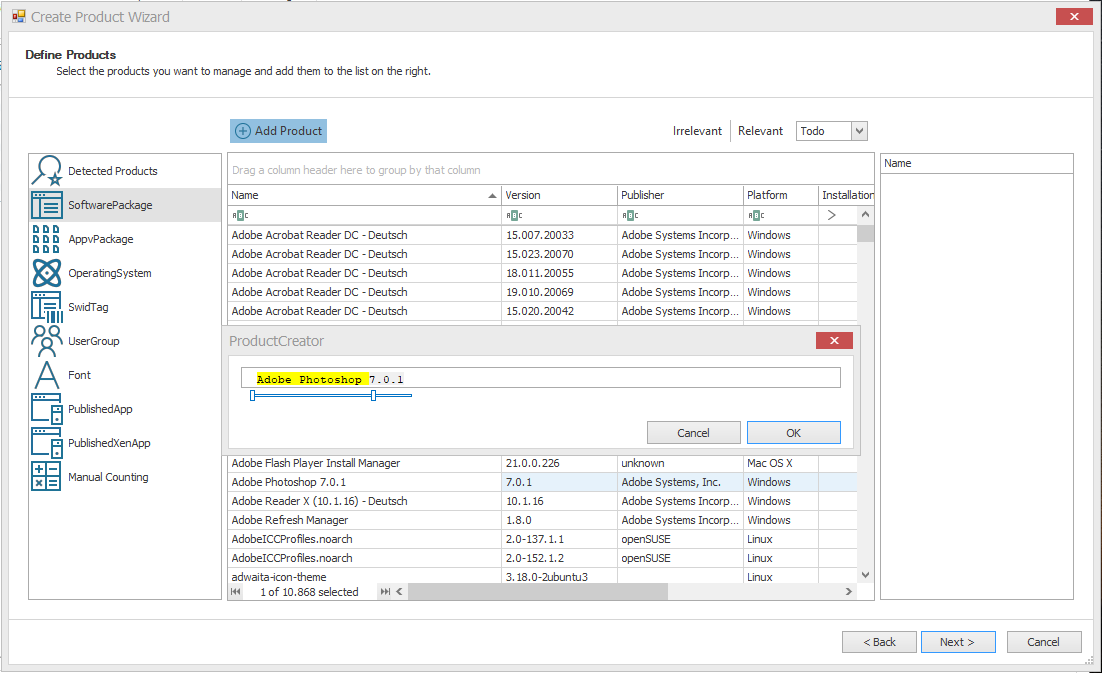
Important
All packages can be categorized so that you can tag packages as important. Navigate, for example, to the node Software -> Software Packages and use the Custom Property widget. In this way, several result rows can be marked with Shift and Control keys and then marked as "Irrelevant" or "Relevant". A false or true is then set in the "Hidden" column.
By selecting the drop-down menu in the license mangement wizard, the result list can be restricted from "All" to "Todo". All packages that have not yet been categorized or marked as relevant are counted as "Todo".
So it can be guaranteed that newly recognized packages appear automatically in the todo list and unimportant packages are hidden 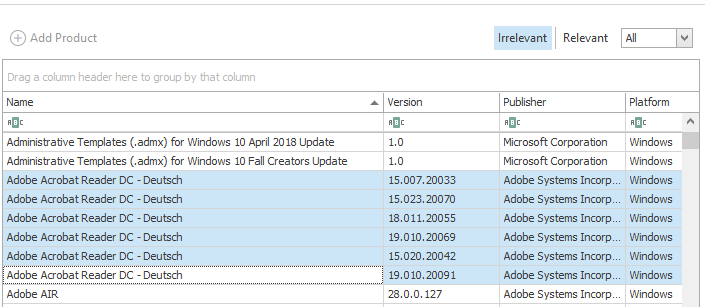
Tip
The categorization can also be done outside of license management in the list of all software packages. It might also be helpful to create a Task so that if new unclassified packages are found, an email is sent.
Of course, if a product has already been added via the Detected Products, it no longer needs to be added via the Software Packages.
AppV Packages
If AppV packages (version 5) were found, they can be added analogously to the software packages.
Operating Systems
Normally, the relevant operating systems should already have been added via the recognized products. If this is not the case, you can also add them via this list.
SWID tags
Software Identification Tags (SWID tags) provide information about installed software, such as name, major version, subversion, etc., and are defined in IEC standard 19770-2:2015. This means that existing software can also be recognized by SWID tags if the software publisher has paid attention to the relevant standard - which is currently very rarely the case.
The products can then be added analogously to software packages.
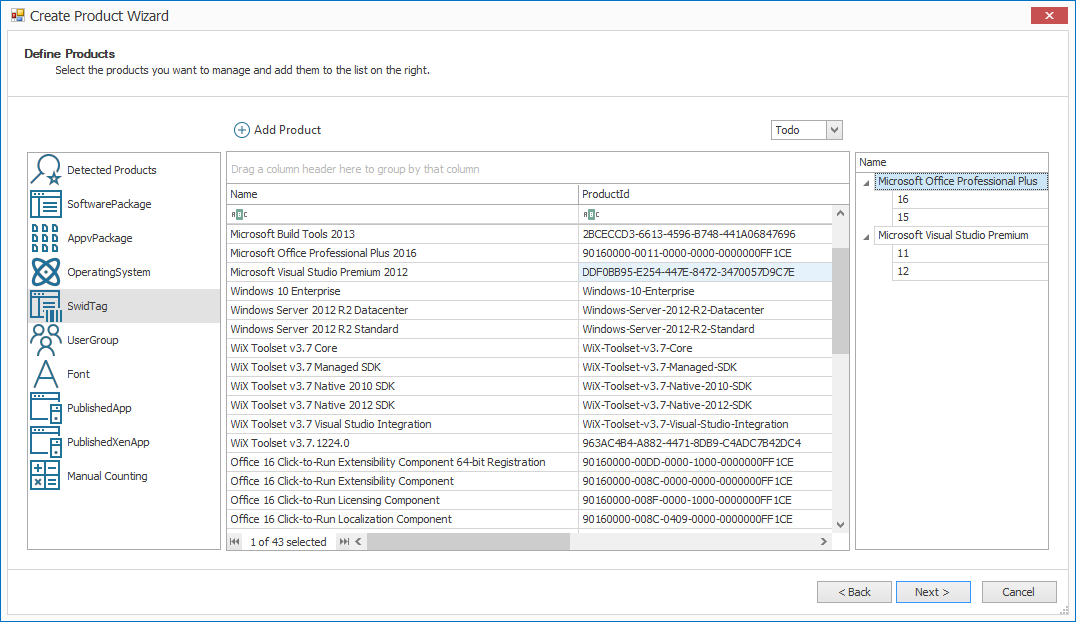
User Group
To manage products for which all members of an AD group require a license, the groups can be added to license management.
Info
This includes, for example, Client Access Licenses (CALs) which are user-related, i.e. User-CALs for the SQL Server, Windows Server or Exchange Server. Because of Microsoft's license terms, all users who theoretically have access to a product must be licensed, even if only a subset actually uses the access. We therefore recommend that you restrict access to these products via group memberships and then add these groups to license management.
Through the regular inventory of the AD, changes in the number of members of a group are recognized and the license requirement changes accordingly.
Tip
If your AD groups contain not only real persons, but also users such as "Reception" or "Admin", you can first create your own query that excludes these members and then add the group via the Manual Counting.
Please always observe: Only real persons are subject to licensing. If a user has more than one account, he only has to be counted once.
Cloud Subscription
If data from Microsoft365 has been gathered during the online data collection, these subscriptions can be displayed in license management. The products to be managed can be selected and added.
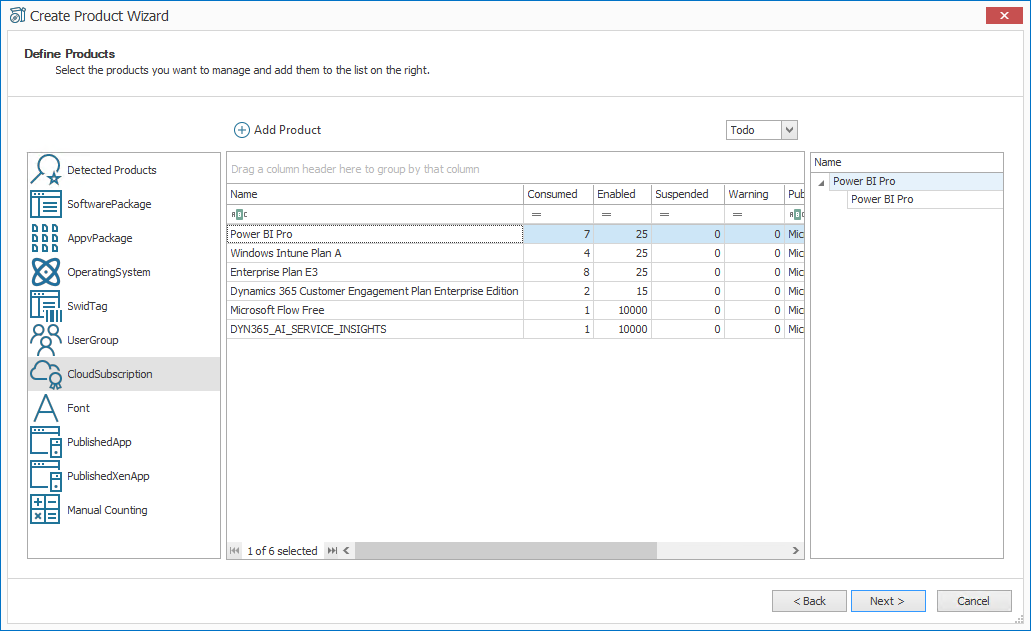
Tip
For cloud subscriptions we recommend - as for all other products - to add them via the item "Detected Products", because only in this case the checkbox "Assign licenses to products and versions automatically if possible" is checked, which means that the manual assignment of licenses is no longer necessary.
Important
The API, which is used to retrieve data from Microsoft365, unfortunately does not provide the ability to read the expiration date of licenses. Therefore we recommend to manually enter the expiration date for the licenses (End).
Font
If you use licensed fonts in your company, the fonts can be added in the same way as software packages.
Publish App / XenApp
If programs have been published via a terminal server or remote desktop server, these can be managed in license management. The members of the groups for which the application was published are counted as consumers.
Manual Counting
Manual counting can be used to store the number of result queries as consumers in license management. This is always necessary if none of the supplied nodes delivers the correct result. For example, a custom query could be created that lists all thin clients and defines them as users for remote desktop licenses.
Info
In addition, a constant number of consumers can be entered here if the number of consumers cannot be determined automatically via LOGINventory, but you know how many consumers exist.
Example
In order to manage the product "LOGINventory" in the license management, the Manual Counting can be selected and in the next step , the "Assets" node can be selected as the source, because every successfully inventoried asset needs a license.
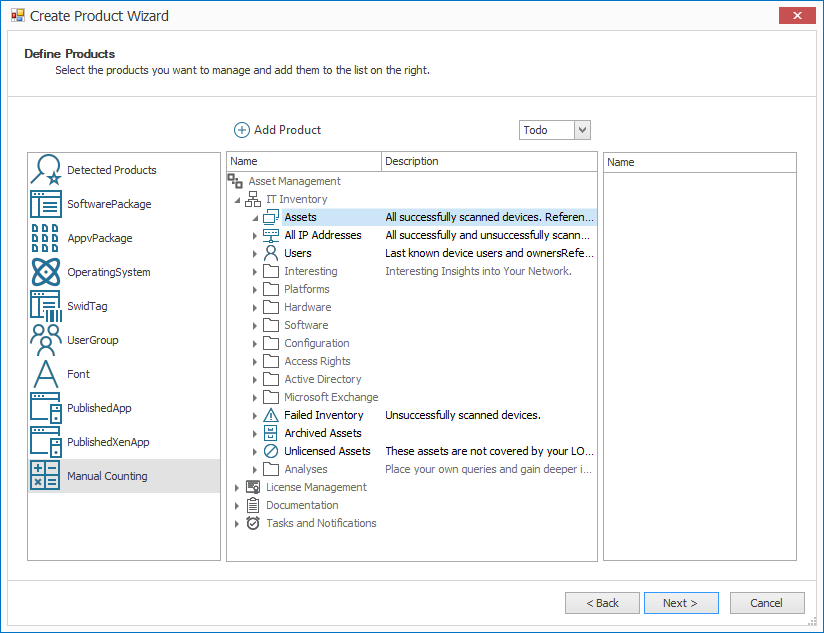
Configure Products
In the next step, you can set for each product how the license consumers are calculated exactly and which versions are to be created for the respective products.
For each product you can define how the license consumption is calculated. Depending on the Metric selected, different setting options are available for this purpose.
Note
The option "Assign licenses to products and versions automatically if possible" is only available for cloud subscriptions and Windows operating systems where OEM licenses can be read.
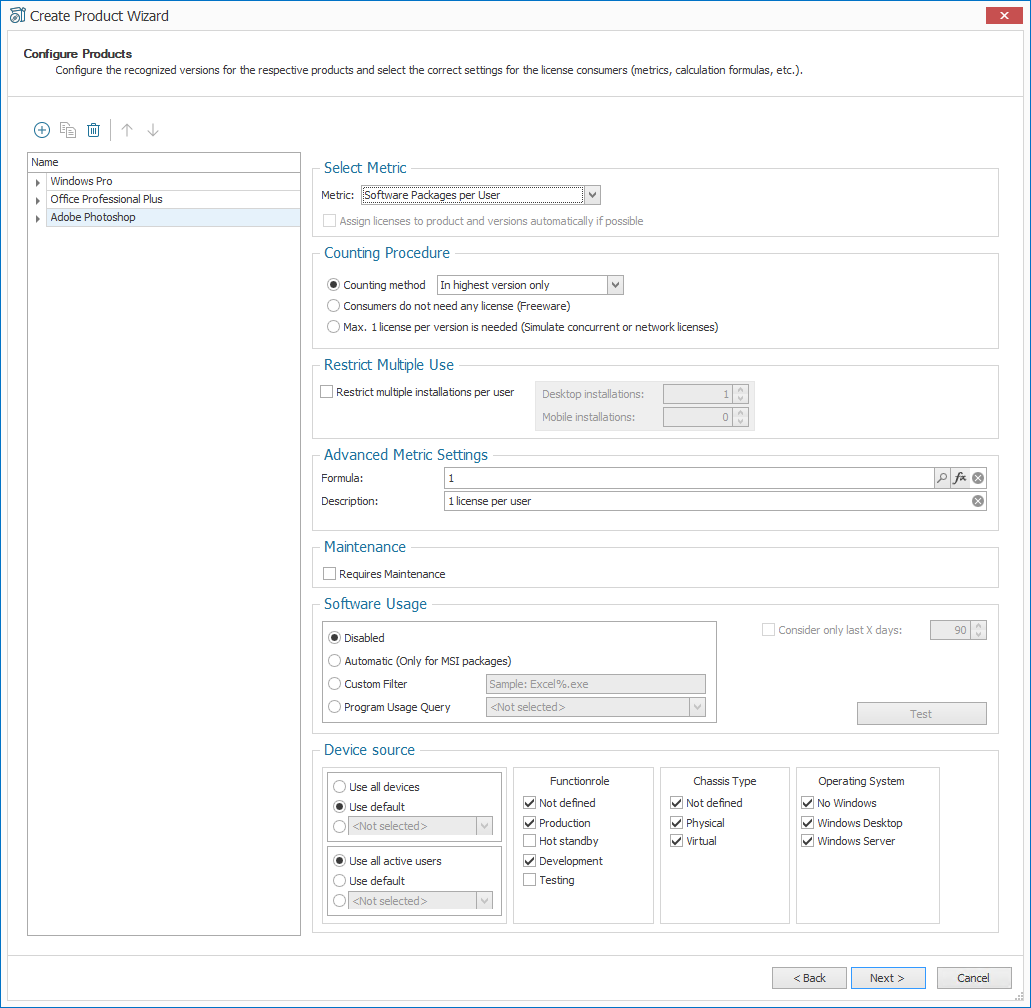
For example, you can set how the licenses are counted (in highest version only or in any version), whether there is a calculation formula for license counting (normally: one license per device), whether maintenance licenses are required, whether multiple use by a user is possible on different devices and which device types should be included in the license count.
With the device source, for example, virtual machines can be excluded from the license count or queries other than the asset node or all active users can be set as the source of the users.

Tip
The Custom Property FunctionalRole is created by default and available in the Assets node and is suitable for marking test devices as such and thus excluding them from the license count, since test installations often do not require a license.
In addition, Usage evaluation can be activated for software products.
Info
For automatically detected products the settings are already preset here and should only be checked for correctness.
Calculation Formula
Most products require one license per device. LOGINventory can also map products such as SQL Server or Windows Server, where the number of licenses consumed can depend on the number of CPUs or cores. The corresponding formulas are supplied as templates for this purpose. These can be selected by clicking on the magnifying glass symbol.

Of course you can also create your own formulas if the product you want to manage is not listed here.
Software Usage Evaluation
For software products (not operating systems), various options are available to activate the usage evaluation.

In order to know whether a product has been used, LOGINventory needs to know which file can be used to detect the use of the product.
For software installed via an MSI package, the usage evaluation can be detected automatically. In the background, a mapping is made between the path in which the program was installed (SoftwarePackageInfo.InstallLocation) and the path from which a program is started (ProgramUsage.PathName). If this mapping is not successful or no InstallLocation is unknown, a manual assignment must be made so that the usage can be evaluated. For this purpose it may be necessary to set a custom filter or to select a query which evaluates the use of the corresponding product.
To test whether data is available for one of the options, the "Test" button is intended. This will show you how often the product has been used in the selected period (recommendation: 90 days), has not been used and how often the use cannot be determined.
Attention
You will only receive reliable usage data if the Software Usage Evaluation Agent has been distributed. Otherwise, incomplete data may be supplied!
Info
The ProgramUsage table shows for each relevant file (.exe, .bat or .jar) when and where it was last executed by whom.
Example
For a program named "AFS-NetClientX6" the usage should be evaluated. It is noticeable that the InstallLocation differs from the ProgramUsage.PathName. (AFS is started via the network). Therefore, in a new Program Usage query, PathName has to be filtered to "afs".  In this query the filter condition can still be adjusted, so that really only relevant entries remain:
In this query the filter condition can still be adjusted, so that really only relevant entries remain: PathName resembles %\AFS\AFS-Order\Order.exe
Now the newly created query can be selected in the license management of the product and the mapping is carried out correctly. 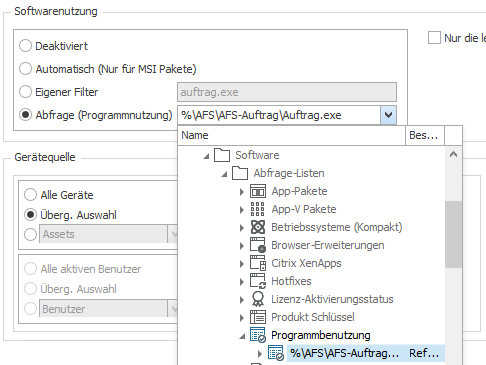
Host Licensing
It may also be necessary to map the licensing of an operating system or a software product per virtual machine. LOGINventory provides the metrics Operating Systems per VM via host and Software Packages per VM via host.
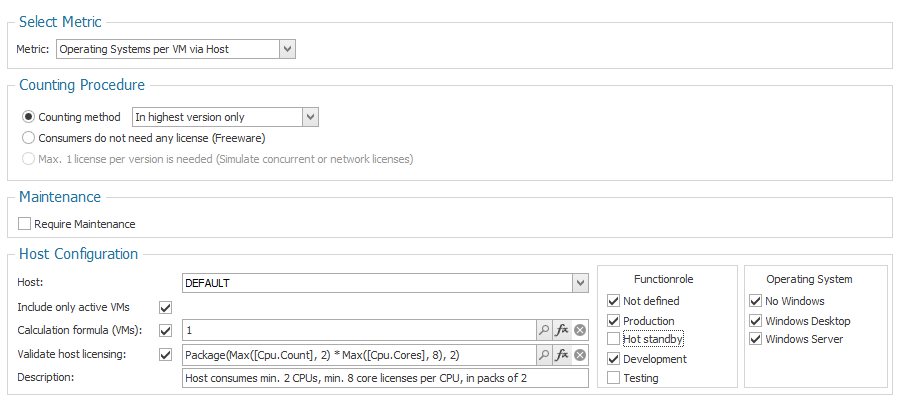
These two metrics have an additional setting option for host configuration. Here you must first select the host on which the corresponding VMs are running.
Info
Operating system licenses are always hardware-bound (also for VMs). Therefore, the products may have to be added several times, for each host individually, to the license management. The linked licenses are then inherited by the VMs.
To calculate the number of allowed VMs, you can again select a formula from the templates. Now you can set whether the host licensing should also be checked. This means that all of the host's hardware must first be sufficiently licensed for virtualization rights to be calculated for the virtual machines at all. This is always necessary for Windows servers, but not necessarily for Microsoft SQL servers, for example, since it is also possible here that only the number of CPU cores assigned to a VM must be licensed.
Special Case: Manual Counting
If a query was selected for manual counting, correction factors can be added if necessary or further queries can be selected as source and then an arithmetic operation (addition or subtraction) can be selected accordingly.

Info
If the query is to be accepted in this way, the default settings "0" for Constant number and "Addition" for Calculation operation are correct, since "0" is then added to the number of lines.
Definition of Versions
By clicking on the arrow next to the product name you can define which versions should be created. The currently available versions are automatically detected and added. The names of the versions first correspond to the version number, but they can be changed manually. The preview for each version shows which installations for the respective version are considered consumers.
For each added product a corresponding query including the created versions will be added, e.g. if it is a software package, a query on the product and below for the versions will be added below the node "Software Packages".
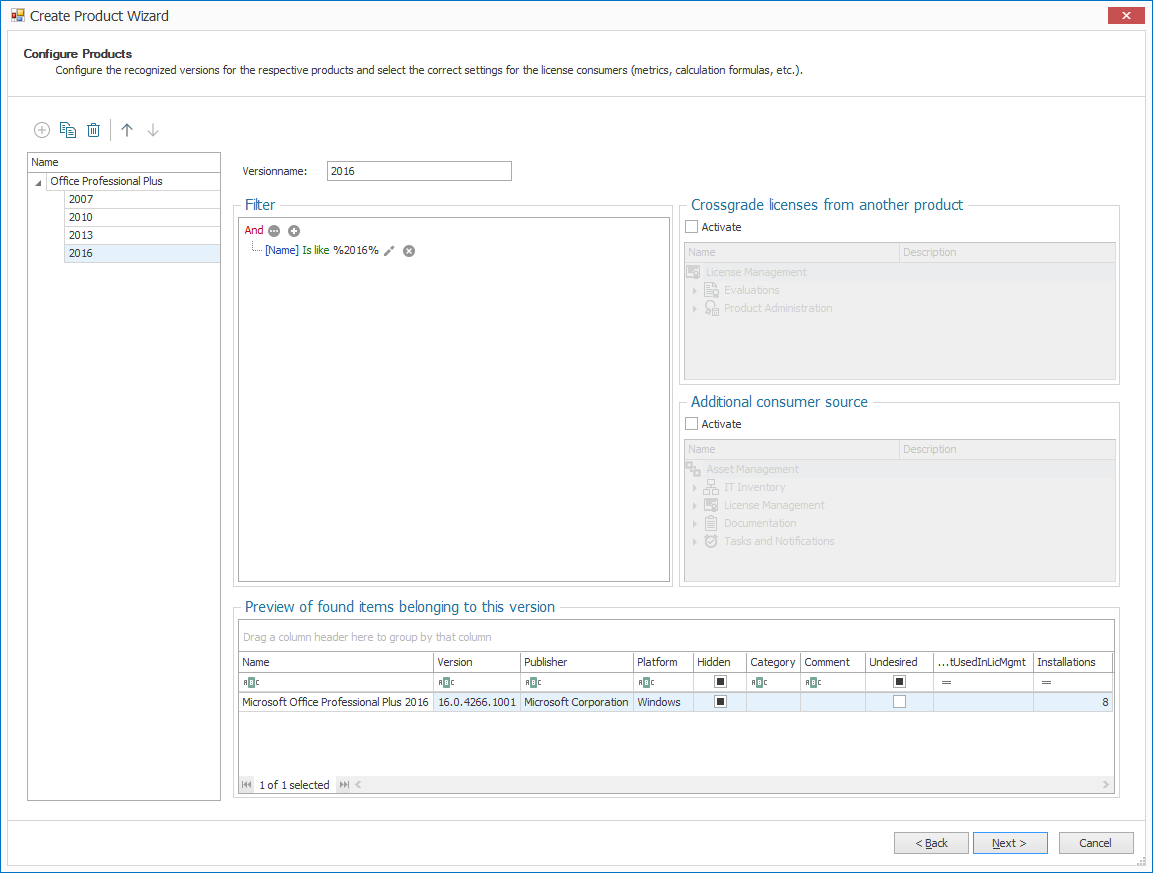
It may be useful to create further missing versions here and to adjust the order correctly so that the calculation of Downgrades is carried out correctly.
Example
If only version 8 and version 11 of a product were found, only these two versions will be created (except the product was detected automatically). Versions 9 and 10 should now also be created here. Then you can set, for example, that version 11 has a downgrade right of two levels, i.e. versions 10 and 9 may be used, but not version 8.
Important
If, for example, software packages appear in the wizard that are incorrectly added to the respective version, you can subsequently adjust the corresponding query and remove the incorrect entries by adding filter conditions.
Example
If, when checking the versions of a software package, you recognize that an installation that ends in "Client" is also counted as a consumer, you can exclude it. To do this, go to the newly created product below the "Software packages" node in the "Software" folder and adjust the filter condition so that no installations are included if "Client" is included in the name. The license status of the product can then be recalculated and the "client" installations are no longer counted.
Special case: Crossgrade licensing
If licenses of another edition (e.g. Windows Server Enterprise) may be used for a product (e.g. Windows Server Standard), this can be set here. For each version, you can set which other product licenses may be used for which version.
Special case: Additional consumers
If it is not only the installations detected by LOGINventory that are to be counted as consumers of a product, manual queries can be selected that are considered as additional consumers.
Example
This is necessary, for example, if Office licenses of fat clients and thin clients are to be managed with a single product. On the fat client, LOGINventory will automatically detect that Office is present, whereas thin clients may not. In this case, a query containing all thin clients can be selected as additional consumers.
In the case of "per device" licensing, only queries containing devices can be selected. With "per user" licensing, queries for users and devices can be selected. In this case, the "owners" of the devices are counted as users.
Example
If you want to add users to a certain AD group as additional consumers, you can first create a query that filters to this group. Below you can then display the corresponding user accounts and below them the users as a query, so that they can also be used here.
Once all settings have been made, the product configuration can be closed by clicking on "OK" and an overview page with the product details is displayed.
Product Details
A node is now created for each product in license management. Licenses can be stored here, the license distribution, the consumers of the licenses, the usage evaluation, and a summary of the product can be viewed.
Attention
The calculation of the license status of a product is not triggered automatically. As soon as licenses have been stored or the settings in the product configuration have been changed, the license status should be recalculated. Since this is a computationally intensive task, the calculation is not performed automatically each time you view the product details. However, the calculation can be initiated manually (right click: calculate license status) or automatically according to a defined schedule.
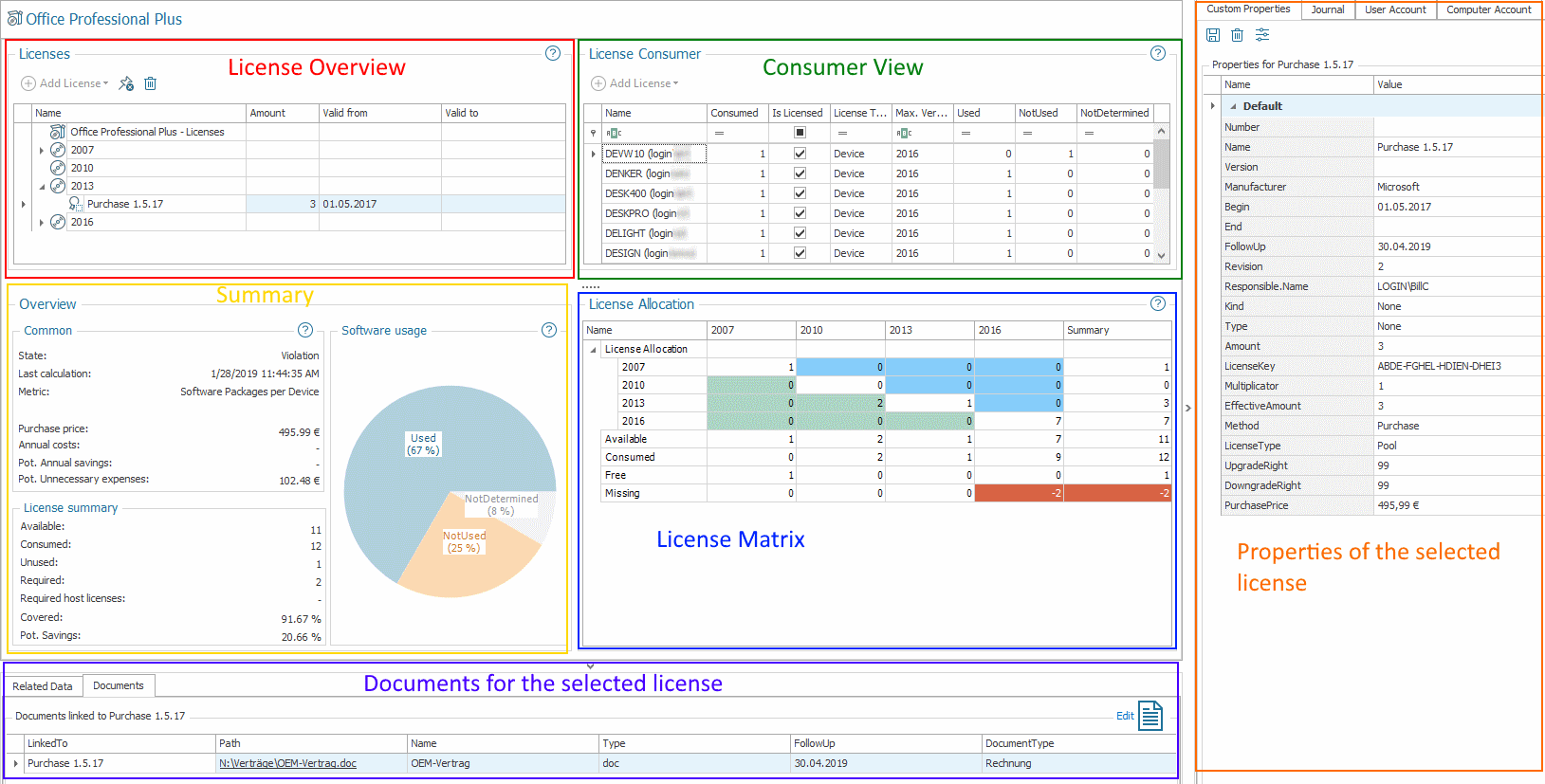
Depositing Licenses
Important
For each product the purchased licenses must be stored manually. This process cannot be performed fully automatically because it is not possible to read out which contracts the company has made and which licenses have been purchased (exception: Windows OEM licenses).
Info
Just because a software was activated with a key does not mean that it was purchased legally. For this reason, license certificates must be deposited. These must also be presented as part of an audit. The fact that certain product keys are known is not sufficient.
License Types
As a general rule, a distinction must be made between two types of licenses: Version-bound licenses (e.g., purchase of Office Professional Plus 2016) vs. Product-bound licenses (e.g., subscription of Office365). LOGINventory supports different subtypes of these licenses:
| License type | License type | Properties | Example |
|---|---|---|---|
| Pool License | Version-bound | Pool licenses are not assigned to specific consumers and can therefore be used by any consumer in the respective version (or, if a downgrade right exists, also in older versions). | Purchase of 5 FullL Packaged Products (FPP) from Microsoft Office Standard 2013 |
| Device License | Version-bound | Device licenses are explicitly assigned to specific devices. If they are not assigned to a device, they are not valid. If the software is not available on the assigned device, the license is not used. Note: If assets with assigned device licenses are archived or deleted, the licenses will also be archived or deleted since they are directly bound to the device. |
Purchase of a computer with pre-installed Windows (OEM license). This license is computer-bound. |
| User License | Version-bound | User licenses are explicitly assigned to certain users. If they are not assigned to a user, they are not valid. If the corresponding user has not installed the product on any of his devices (Custom Property "Owner), the license is not used. User licenses can allow one user to use the software on multiple devices. | Microsoft Windows Server 2016 User-CAL or Microsoft Visual Studio Professional 2017 as Standalone License |
| Subscription License | Product-bound | One Subscription License entitles the user to use all versions of the respective product during the validity period. | Microsoft Visual Studio Enterprise Subscription |
| Maintenance License | Product-bound | A maintenance license is only taken into account in the calculation if "Requires maintenance licenses" is checked for the product. In this case, a product must have at least as many maintenance licenses as it consumes, so that the product is not sublicensed. A maintenance license alone is not enough to license a product. In addition, subscription or version-bound licenses must be available. | Software Assurance for Windows Server |
Manual Storage of Licenses
There are two ways to store licenses: Either the appropriate product or version is selected and then the desired license type is added from the dropdown menu or a consumer is selected from the list of consumers and then Add License is selected.
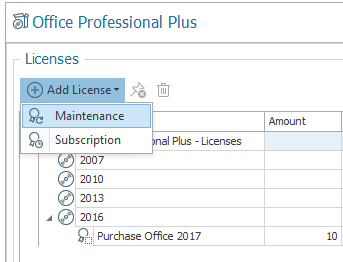
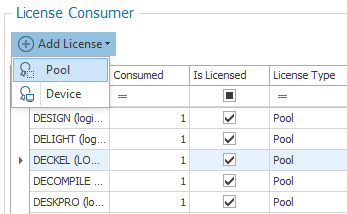
Important
If a device or user license is added to a consumer, it is linked directly to the consumer. Otherwise, this license must be assigned to a consumer using the Custom Properties widget for it to be valid.
If a license has been added, the number and - if available - validity dates can be set directly.
Important
To store further properties to the licenses, the widget Custom Properties can be opened when a license is selected. A variety of predefined properties such as license key, purchase price, resubmission date, etc. are already available. Further fields can also be defined here to define additional properties (free fields). 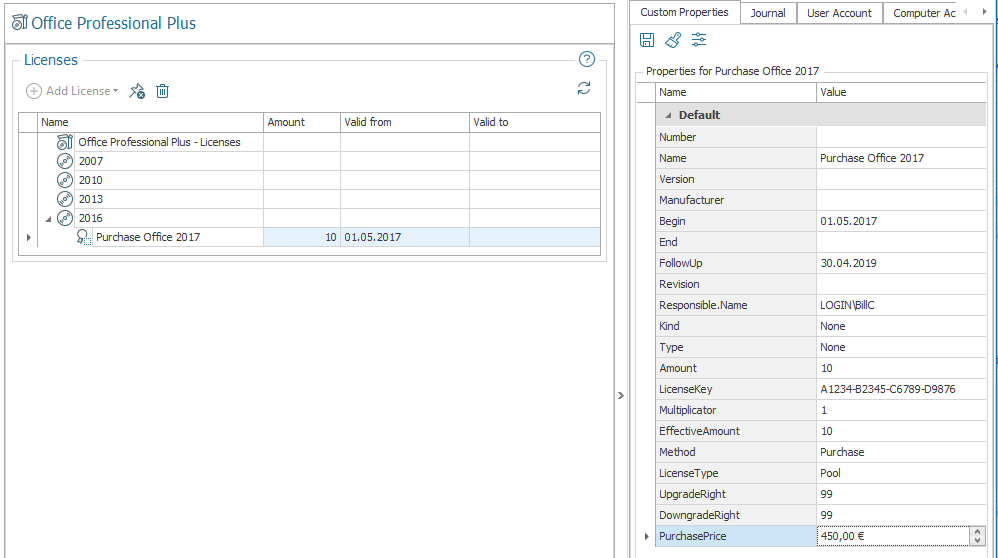
Many of the stored properties are then also used in reports and, for example, the financial values are used to calculate potential savings.
Important
Furthermore, it is recommended to also deposit a corresponding license document for each deposited license, which proves the license ownership (e.g. PDF of the invoice). The widget Documents is used for this if a license is selected in the license overview. The storing is important so that you can keep track of where the deposited figures come from and to have the license certificates directly available as part of an audit. 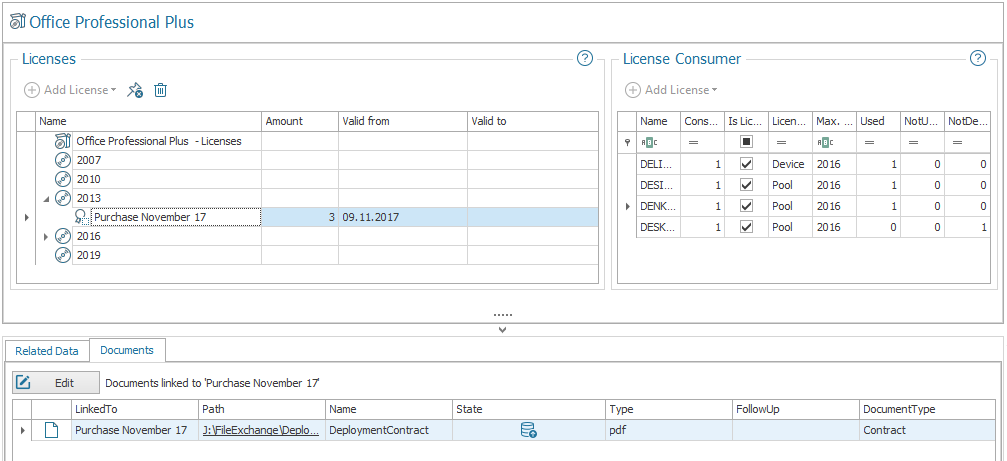
Whenever new licenses have been stored, the calculation of the license status of the product is recalculated. Thereupon you can see in which version how many licenses are available and how many are consumed. The color of the circle on the product indicates if there are enough licenses available.
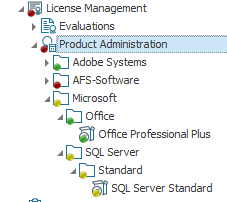
If there are enough licenses available, the circle is green. If the product requires maintenance licenses and only sufficient pool, device, user or subscription licenses are available, but not sufficient maintenance licenses, the circle is yellow. If there are not enough licenses available, the circle is red.
The folder above the product will have the same status if all products below it have the same status.
Assignment of Already Created and Automatically Recognized Licenses
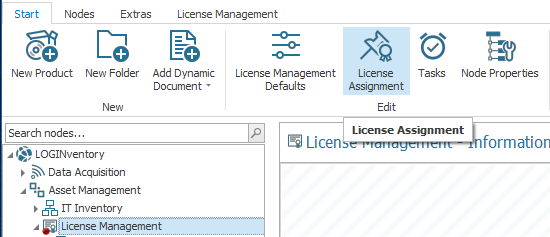
In addition to manually storing licenses, OEM licenses that have already been created and automatically recognized can also be assigned. To do this, you can open an interface via the item License Assignment from the ribbon menu in which all unassigned licenses are visible.
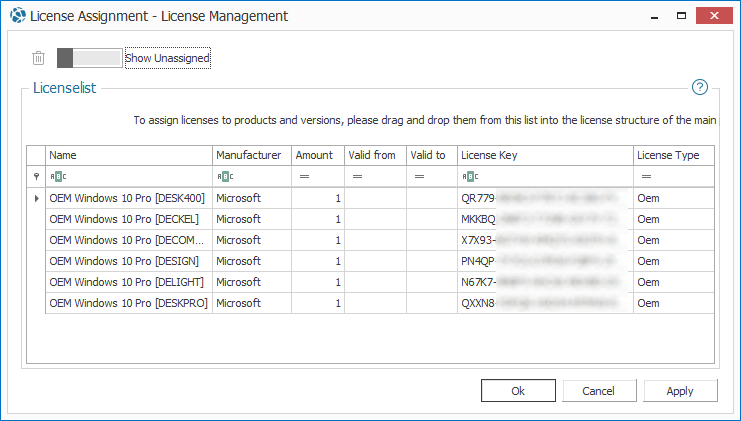
These licenses can then be added to the corresponding products or versions via drag & drop.
The licenses for which the assignment to the product or version has been removed are also listed here.
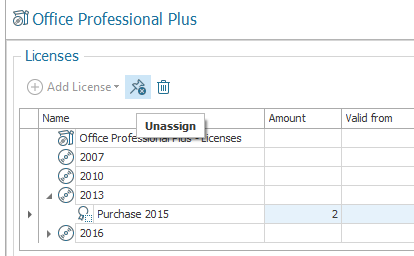
Importing Licenses
With the Data-Import you can import information about existing licenses from csv files. The Data-Import is described in detail here.
Evaluation of the License Matrix
The license matrix shows in which version how many licenses are available and used. By clicking on the arrow next to License Allocation the license matrix can be extended and it is visible where downgrades or upgrades have been carried out.
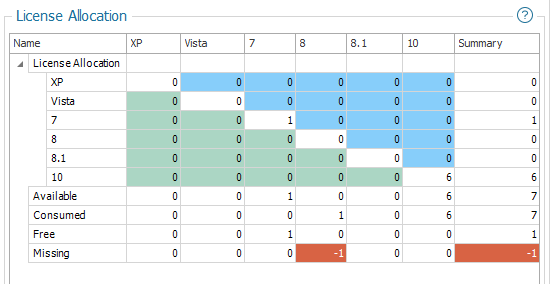
Upgrades and Downgrades
For each stored license you can set in the Custom Properties for how many levels an upgrade or downgrade is possible. If this value is set to "0", no upgrade or downgrade can be performed. If, for example, a downgrade right of "2" is set, this means that the previous two versions may also be used with this license.
All versions created during definition of versions are authoritative for this. Therefore the order of the versions can be adjusted with the help of the arrows.
Example for upgrade
For example, in order to map the free upgrade from Windows 7 licenses to Windows 10 licenses in LOGINventory, the licenses purchased in version 7 can first be entered in version 7 as normal. Then an upgrade license can be added to version 10. To do this, the Custom Property "Method" must be changed from "Purchase" to "Upgrade" AND for Windows 7 licenses, an "UpgradeRight" of at least "3" must be stored. This means that Windows 7 licenses can be upgraded to Windows 8, Windows 8.1 and Windows 10 (a total of three levels).
Software usage evaluation
LOGINventory offers the possibility to find out which software in your company is actually used by whom with the help of the specially developed usage statistics agent LOGINuse. In this way, expensive, unused software packages in particular can be identified and the number of licenses reduced.
Already without distributing an agent LOGINventory provides usage statistics for programs on the individual devices using data from Windows Explorer. This statistic is available for all supported Windows operating systems from XP onwards in the respective user context, but only takes into account the applications started via the Start menu, desktop or Explorer. Starts via the taskbar, for example, are not counted. Therefore, entries in the usage statistics without using the agent can be interpreted to mean that the presence of an entry means that the program was started safely, but the absence of an entry cannot be reinterpreted to exclude program usage.
In order for this usage data to be available in license management, the usage evaluation must be activated in the Product Configuration.
The pie chart then shows how often or rarely the corresponding product is actually used and what savings potential exists. The list of consumers also shows where the product has been used or not used.
The data for use can then look like the following:
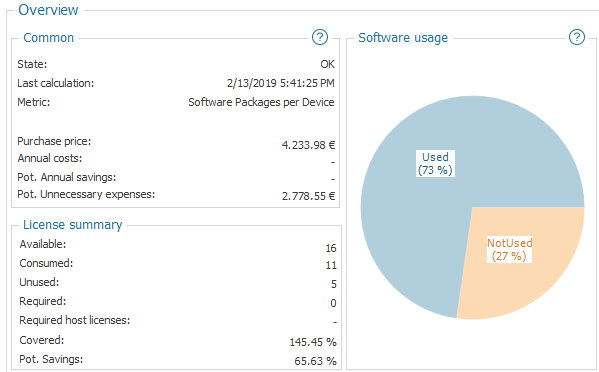
Examples for Managing Different Products
Note
In general we recommend to add all products via the list of Detected Products to the license management, because the correct settings will be made automatically. Occasionally it may be necessary to identify products by other sources in order to map them correctly in license management.
Management of User CALs
If your company uses user CALs (CLient Access Licenses) for a product (common examples would be Exchange Server User CALs, SQL Server User CALs,...), it makes sense to map them in license management.
Important
The basic procedure in LOGINventory is the same for all possible cases: You need a numerical value indicating how many CALs are used and a number of CALs available in your company. The difference can then be used to determine whether you are under- or over-licensed, or already have the right number. The number of CAL consumers in LOGINventory can of course be calculated dynamically by a query.
When user CALs are used, all actual real persons who theoretically have access to the application must generally be licensed. This means that the number of accounts from the AD or the number of mailboxes on the Exchange server often does not provide the correct number, because e.g. admin accounts, service accounts or mailboxes such as "reception" are incorrectly counted. It should also be noted that one account could be used by several real persons.
1st Option: Using a Group From the AD
The simplest option, if already available, is to use a group from the AD containing all the real people working in the company. If the application is only used by a certain user group, of course only this group can be added to the license management. If such a group is used, it must of course also be ensured that processes exist in your company that ensure that the right people are always included in the group (e.g. adding new hires). This organizational measure of regularly updating the groups is required when used in license management.
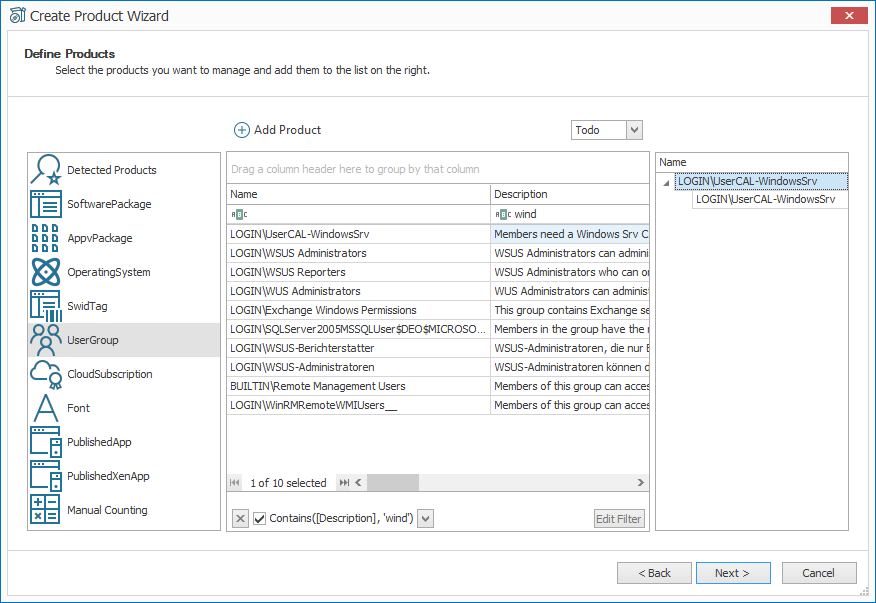
In the wizard for creating license products, UserGroup must be selected on the left side and the corresponding group marked by a double click. In the next step no further settings are necessary.
In the product overview all active members of the group will be listed. The product can then be renamed by double-clicking on the node and the existing CALs can then be stored as licenses as with any other product.
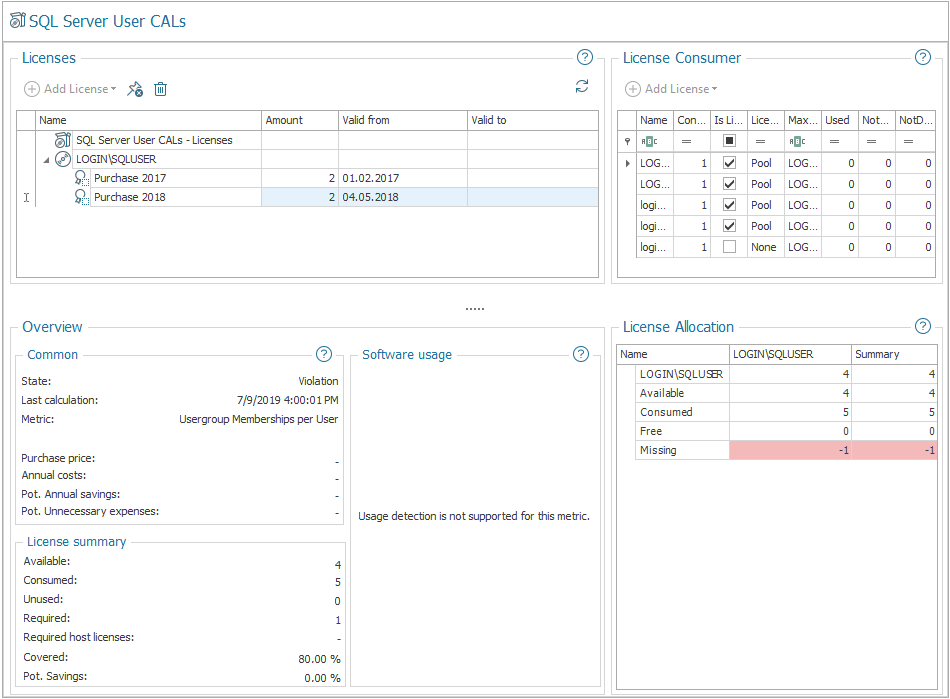
2nd Option: Using Your Own Query
Instead of creating a user group, you can also create your own query, where the number of result rows represents the number of consumers. For example, when managing Exchange Server User CALs, it is a good idea to modify a copy of the existing mailbox query so that unneeded accounts no longer appear in the mailbox list. To do this, first create a duplicate of the Mailboxes query in the Microsoft Exchange folder. The resulting entries for non-consumers are now removed from this query by means of appropriate filter conditions. This includes e.g. service accounts, admin accounts, etc. Often, real persons can also be identified by the fact that a blank character is contained in the name. However, the filter conditions must be adapted to the actual circumstances.
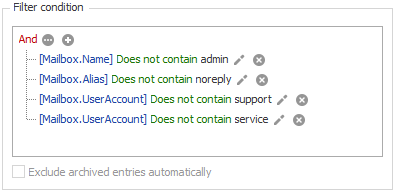
Once the query has been fully customized, a New Product can be added to the license management. Select Manual Count as source and navigate to the corresponding query. In the next step it would be possible to add correction factors etc., but this is not necessary in this case.
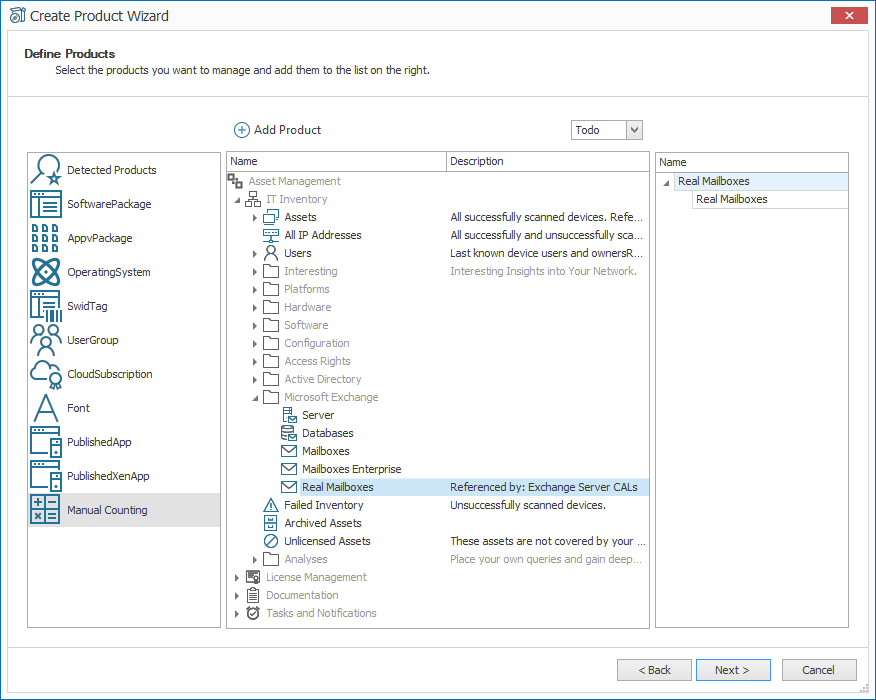
Once the product has been added, you can see the number of result rows of the selected query at the consumers' end and licenses can be stored as usual. It also makes sense to rename the product in this case.
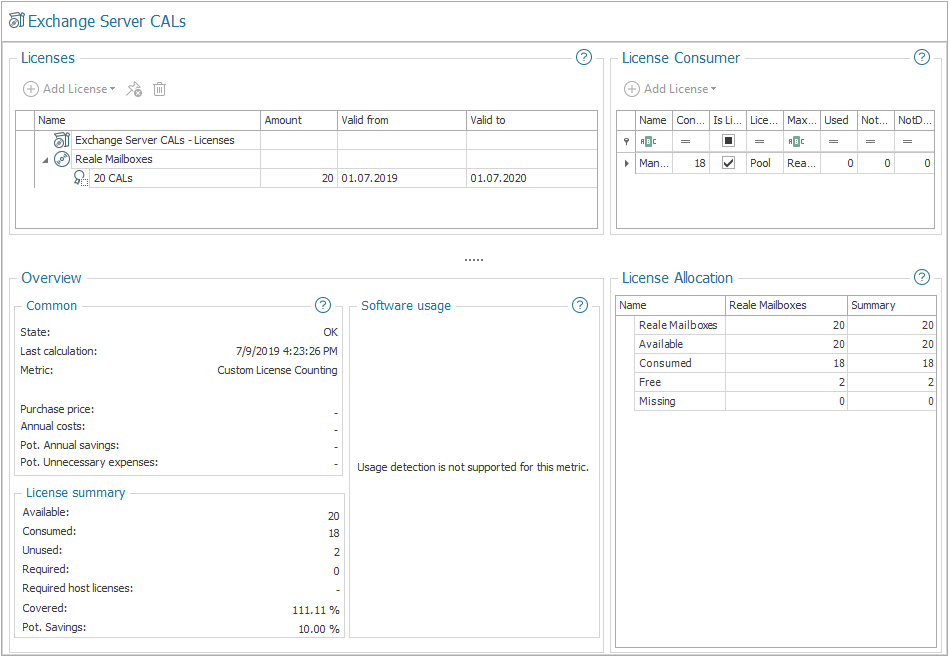
Management of Device CALs
When managing products that require device CALs, it is also necessary to create a query that has the number of consumers as the number of result rows. This can be created using the same procedure as described for User CALs and added to License Management.
Of course, an existing query (e.g. Windows Clients in the Platforms folder) can also be added in this way.
License Management Documentation
When products and licenses have been added to the license management, different aspects can be documented with the help of different reports. These reports are described in detail in the topic Documentation and can be applied to the products from the ribbon menu. If all products are to be included in a report, the query All Products below Evaluations can be selected.
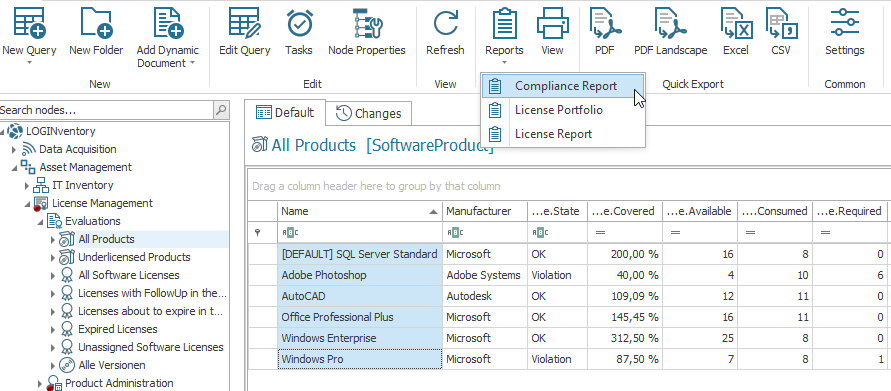
Info
Of course you can customize all included reports and create your own.
In addition, Dynamic Documents are provided, which can be used in the context of an audit announcement from Microsoft. This so-called Microsoft Deployment Summary is available under the node Documentation and provides the required key figures for device, software and license usage.
Automation in License Management
All stored values can also be used in own queries. For example, queries can be created that filter for resubmission date, license status, and the like. Some examples for such queries are already delivered in the node Evaluation below License Management. These queries are suitable for positioning Tasks on them. So you can stop sending e-mails if underlicensing is noticed, contracts expire soon and much more.
In addition, the current compliance documentation can be filed or sent monthly, for example.
Attention
In order for the notifications to refer to the current license status, the calculation of the license status must be periodically repeated. You can use a schedule to define when the calculation is to be carried out. Depending on the number of products managed and the number of users, this intensive task can also take a long time, which is why it is advisable, for example, to calculate the license status regularly if LOGINventory is not used (e.g. at night) or before tasks are evaluated that relate to the license status.
To set the schedule for recalculating the license management status, a task can be defined on the license management node. Here you can select only "License Calculation" as action.
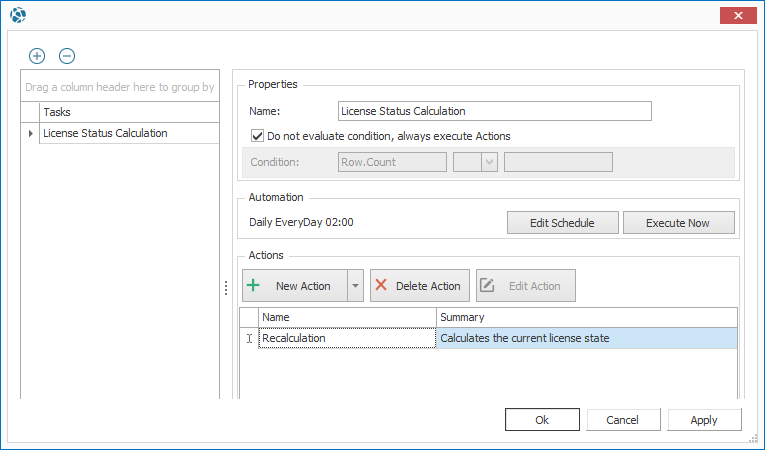
By default, the recalculation is performed at 2 a.m. each day.
License Management Preferences
In the License Management Defaults, the data sources for products and consumers can be adjusted. For each entity, queries other than the standard queries can be selected, which means, for example, that not all assets are considered as potential consumers, but only a subset (freely definable query). This can be used, for example, if license management is to be performed separately for different business units (see below).
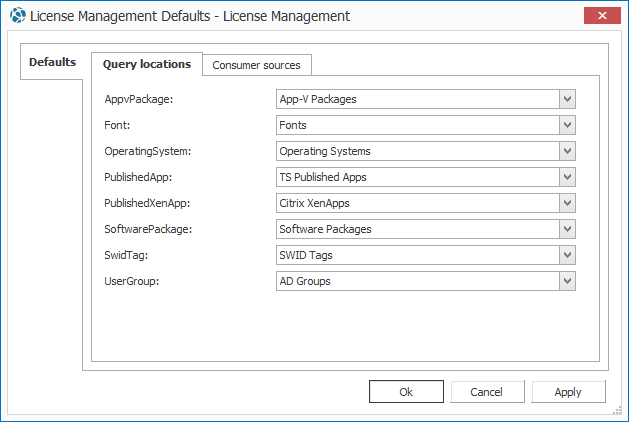
Normally, however, no settings are necessary here.
Use of Multiple Separate License Management
In special cases it may be necessary to use a separate license management. This is the case, for example, if certain products in your company are managed by another business unit (for example, headquarters).
It may then be necessary to create several license management nodes and store other data sources for consumers and products there in the license management default settings.
To create an additional license management node, either the Asset Management or the IT Inventory node must be selected, then a New License Management can be created with a right click.
